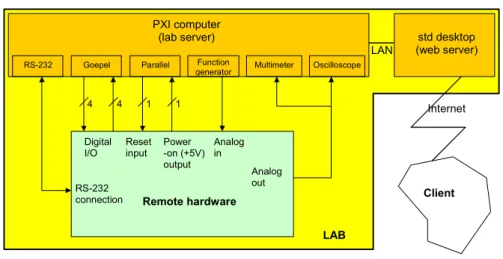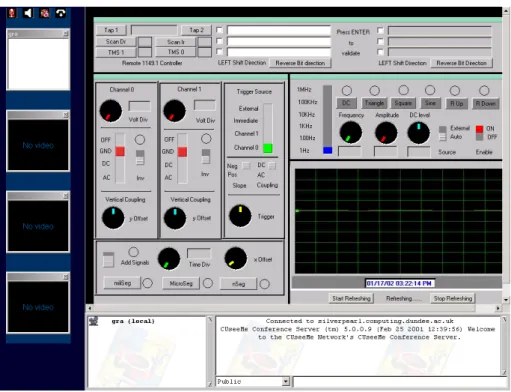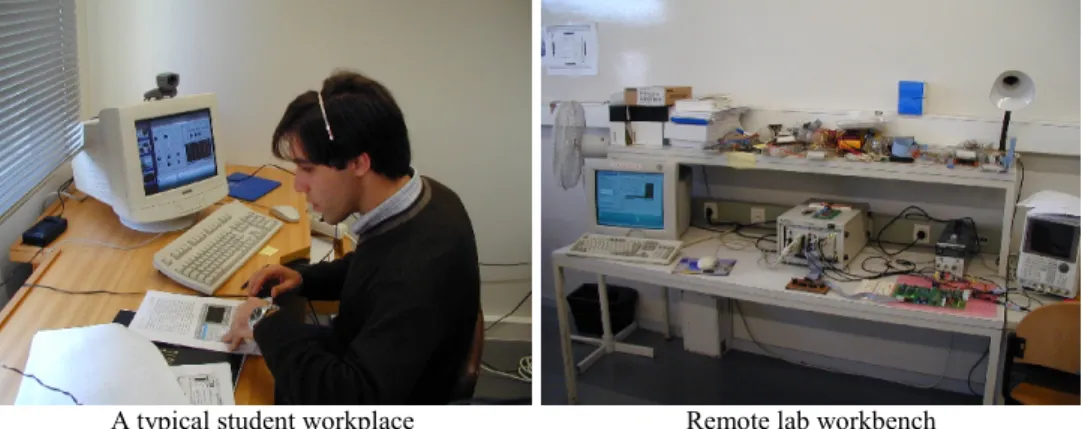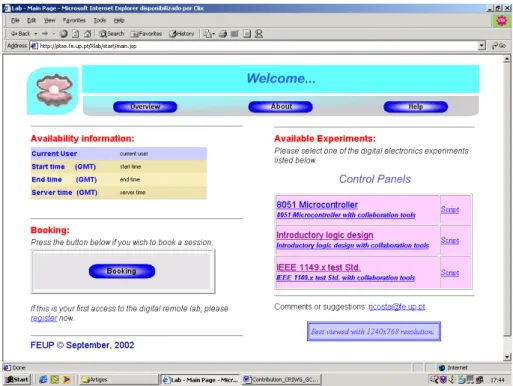Collaborative learning in a web-accessible workbench
J. M.Martins Ferreira1, Gustavo R. C. Alves1, Ricardo Costa1, and Nick Hine2 1Faculdade de Engenharia da Universidade do Porto (FEUP / DEEC), R. Dr. Roberto Frias,4200-465 Porto, Portugal
{jmf, galves, rjcosta}@fe.up.pt
2University of Dundee (Department of Applied Computing, MicroCentre), Park Wynd, Dundee DD1 4HN, United Kingdom
nhine@computing.dundee.ac.uk
Abstract. Web-based course management and delivery is regarded by many
institutions as a key factor in an increasingly competitive education and training world, but the systems currently available are largely unsatisfactory in terms of supporting collaborative work and access to practical science facilities. These limitations are less important in areas where “pen-and-paper” courseware is the mainstream, but become unacceptably restrictive when student assignments require real-time teamwork and access to laboratory equipment. This paper presents a web-accessible workbench for electronics design and test, which was developed in the scope of an European IST project entitled PEARL, with the aim of supporting two main features: full web access and collaborative learning facilities.
1
Introduction
Web-based course management and delivery software packages are widely available on the market and are becoming increasingly popular [1]. Easier access to pedagogical contents and flexible schedules are attractive not only to students but also from the institutional point of view, where a rich catalogue of pedagogical web contents is nowadays of strategic importance [2]. However, and in spite of its fundamental importance for students in practical science domains, effective remote access to laboratory facilities is traditionally ignored in the current generation of web-based education and training frameworks. Moreover, and since teamwork plays an important role in most work assignments, facilities for collaborative learning / work are equally as important and must be able to support real-time communication in the form of audio and video conferencing, besides the traditional text-based chat.
The PEARL (Practical Experimentation by Accessible Remote Learning) project was set up with the objective of overcoming these limitations [3:5]. Funded by the European IST (Information Society Technologies) programme, PEARL is a three-year (2000-2003) project that is being developed to enable practical experimentation for students working together over the Internet or the campus Intranet. The students interact with the remote experiments much as they would in a real teaching laboratory, being able to change parameters and in some cases design experiments. They are also able to observe the results and discuss their actions, using
Internet-based collaborative tools embedded in the PEARL system. It is important to stress that the experiments are real, and as such have an unpredictability that cannot be replicated by simulation.
PEARL presents an opportunity to widen access to real experiments that might otherwise only be offered to those able to get to a suitably equipped laboratory. Four types of experiments were selected for validation purposes:
- Cellular biology, hosted by the Department of Biochemistry of the University of Dundee (UK), which uses computer controlled electron microscopes to conduct cytology studies
- Visual inspection, hosted by the Trinity College at Dublin (Ireland), which is used by engineering undergraduates to carry out image analysis of printed circuit boards
- Environmental analysis, hosted by the Open University at Milton Keynes (UK), designed to support a series of experiments at the residential schools for its popular foundation science course
- Electronics design and test, hosted by FEUP (Faculdade de Engenharia da Universidade do Porto, Portugal), which provides a web-accessible workbench supporting three main types of experiments: test of digital and mixed-signal circuits (for final year undergraduate and MSc. students), microcontroller-based circuits (second year students) and introductory logic design (first year students) The electronics design and test remote lab was developed in the form of a workbench supporting full access via the web and is the main subject of this paper, where a specific emphasis is placed upon the collaborative learning facilities and their implications over such aspects as system design, information system management, and design of pedagogic experiments. The three types of experiments available share a common look-and-feel interface, which varies only according to experiment-specific control / observation facilities.
The access protocol for the microcontroller and the introductory logic design experiments is the same and includes the following steps: i) implementation of the functional specification presented in the lab script (code design or hardware design, according to the type of experiment), which is carried out off-line; ii) design verification by simulation, still off-line; iii) connection to the remote lab server; iv) design upload (code or schematic), remote hardware reset and set up.
The third type of remote experiment supported addresses the test of digital and mixed-signal circuits. While sharing the same user interface design and collaborative learning facilities, all the steps are performed on-line (because all test actions are carried out using an interactive application integrated in the user interface). A set of interim trials have already been conducted in relation to this type of experiments, providing a rich volume of data on pedagogical and technical aspects, including the implications of collaborative learning tools over the network traffic and effectiveness of learning.
The architecture of the remote lab (hosting the web-accessible workbench that supports the three types of experiments) will be presented in the next section, followed by a description of the digital and mixed-signal test experiments, and a summary of relevant aspects related to experiment access and design. Finally, a summary of the main conclusions that are available so far will be presented, together with the current perspectives for future work.
2
FEUP’s remote lab architecture
All PEARL experiments are based on a remote lab architecture that includes three main components: the web server, the lab server and the laboratory equipment. The web server hosts the course management and delivery software (e.g. WebCT or any other similar package), processes all the actions / requests from the user, and communicates via local area network with the lab server. This second machine interacts with the laboratory equipment, either directly or via a dedicated communication and control bus. In the case of FEUP’s web-accessible workbench, the architecture of the remote lab may be represented as illustrated in Fig. 1.
RS-232 Goepel Parallel Function
generator Multimeter Client Internet std desktop (web server) PXI computer (lab server) Remote hardware 4 4 1 1 LAB RS-232 connection Digital I/O Reset input Power -on (+5V) output Analog out Oscilloscope Analog in LAN
Fig. 1. The web-accessible workbench in FEUP’s remote lab. The whole infrastructure
remains the same for the three types of experiments supported, which differ only in the remote hardware that is made available to the students
The lab server is implemented in the form of a 500 MHz Pentium III embedded controller that is part of a PXI rack interconnecting the various workbench instruments. This computer runs Windows NT and is responsible for controlling the following modules:
- A Goepel digital I/O board supporting boundary scan, used to control and observe digital pins, and to interact with IEEE 1149.1 scan chains (for digital and mixed-signal test experiments)
- A function generator board, used to provide analog stimulae in mixed-signal test experiments
- A multimeter board, made available to support simple measurements of analog and digital waveforms
- A two-channel 100 MHz oscilloscope, used to visualize waveforms in pre-defined pins, as specified in each experiment script
LabView was used to build customized interfaces for all the PXI instruments referred above. A commercial tool from Nacimiento (AppletView) was then used to generate the equivalent web interfaces in the form of JAVA-based applets, which the
experiment designers use as building blocks to produce the user interface seen by the students (a given experiment may or may not use all the instruments referred above).
3
Digital and mixed-signal test experiments
A first set of experiments was developed to support the Design for Testability class offered to final year undergraduate and MSc. students in Electrical and Computer Engineering (ECE). The remote hardware for these experiments consists of demonstration boards containing one or more components compatible with the IEEE standards 1149.1 (standard test access port and boundary scan architecture) [6] and 1149.4 (standard for a mixed-signal test bus) [7].
IEEE std 1149.1 defines an embedded test infrastructure commonly present in VLSI components and was developed to support structural testing of digital printed circuit boards. IEEE 1149.4 is essentially an extension of 1149.1, and supports structural and parametric testing of mixed-signal circuits. These two test standards enable full controllability and observability operations via a small number of access pins (four pins for the test access port – TAP – in the 1149.1 std, and two extra analog test access port – ATAP – pins for the 1149.4 std), making it possible to detect open or short circuit faults without requiring physical access to the nodes under test.
The digital and mixed-signal test experiments enable the students to interactively carry out elementary test procedures, using the JAVA-based applets to control the remote instruments, and a simple public domain application to interact with the IEEE 1149.x test access ports.
3.1 User interface
A user interface integrating control and communication tools was built to support a first set of interim trials, described in the following section. This user interface is illustrated in Fig. 2 and provides the following main resources:
- Videoconferencing channels, seen vertically on the left - Text-based chat, seen horizontally on bottom
- A two-channel oscilloscope, occupying the central area (channel 0, channel 1, trigger controls, time base and display)
- A function generator, seen above the oscilloscope display
- Interaction with the IEEE 1149.x test access ports, seen horizontally on top It is particularly important to stress the presence of control and communication resources in the same interface, enabling videoconferencing among the students while the experiment is being carried out. Text-based chat might be considered redundant in this case, but it becomes an effective tool to register actions agreed upon by the team, which may later be printed out by each member as a session log.
Notice that the various resources referred are available to the experiment designer as independent building blocks, and as such the user interface might comprise several windows, one for each specific action or PXI instrument.
Fig. 2. User interface used by the final year undergraduates and MSc. ECE students to carry out
mixed-signal test experiments
3.2 Interim validation trials
A set of interim trials was conducted at FEUP on November and December 2001, providing important feedback concerning the proposed system architecture, usability of the interface and pedagogical effectiveness. An experiment script was previously made available to five groups of two MSc. students, specifying in detail all the actions that should be carried out.
The two students in each pair were located in different rooms and could only communicate via videoconferencing and chat. The script specified which procedure was under the responsibility of each student, but they had to communicate frequently in order to agree upon the specific actions required (this was particularly important, since both were able to control the remote PXI instruments). Additionally, a tutor was available in his office to provide support and clarify doubts, who again could only be contacted via videoconferencing or chat. A typical student workplace and the remote web-accessible workbench are shown in Fig. 3.
In order to explore the implications for the network operators of the campus infrastructures, measurements were made of the traffic generated during the interim trials. These measurements are a good first indication of the impact that a PEARL system will have on the campus infrastructures, and provide early data for exploitation discussions within and outside the project institutions.
A typical student workplace Remote lab workbench
Fig. 3. A student workplace and the remote lab workbench during the interim trials of the
digital and mixed-signal test experiments. Notice the PXI server and instruments, all contained in the rack at the center of the workbench
3.3 Network traffic and collaboration tools
The EtherPeek network monitoring tool was used to capture the network data packets. This tool is able to capture all packets, or only a filtered set, within a network subnet. Statistics such as packet loss, distribution of packets between network protocols, etc., can then be extracted from the data gathered. Traffic between the lab server and the students’ or tutor’s workstations passes to them via the learning material server (which in the this case was a WebCT server), as may be seen in a detailed analysis of the network traffic logs.
The total volume of traffic generated by the experiment was around 650 Kbps, of which around 170 Kbps was between the collaboration server and the various participants’ machines. The traffic between any user’s machine and the rest of the machines is around 160 Kbps. This suggests a requirement for the servers to be on a 100 Mbps LAN segment, and the user / tutor stations to be on 10 Mbps segments with good routing to the servers. The traffic data gathered for the user and tutor machines shows that HTTP traffic represents a higher share than videoconferencing traffic, which confirms the feasibility of using this type of synchronous communication facilities for collaborative work in this context.
The collaboration tools chosen for the PEARL project are based on a web-based conferencing system built around a central server and browser-delivered user interfaces. The web-based approach was chosen in order to enable seamless integration with the interfaces of the experiment instruments. As far as the authors are aware, there is currently only one system available that provides these requirements, the CUWeb system marketed by First Virtual Communications. This system is an evolution of the successful CUSeeMe videoconferencing technologies, and uses a software H.323 compatible videoconferencing server. Because this server is standards
compliant, a variety of software and hardware clients may be used in a single conference.
Application sharing and collaboration tools are supported according to the T.120 standard, but the only viable implementation of that standard is within the NetMeeting software from Microsoft. NetMeeting was not chosen as the principle client for PEARL however because for two reasons. Firstly, it operates as a client application alongside other applications. This would mean that rather than provide the students with a single seamless interface, the various functions of the experiment and student interactions would be provided through different applications on the students' machines. The second reason relates to the way that the NetMeeting client generates the packets of data containing the video and audio content. NetMeeting preserves video quality in its default configuration by encoding all content in a given time period in variable length IP packets. The greater the complexity of the video and audio content, the larger the packets. Other software based clients, including the CUSeeMe video and audio engines sacrifice quality by using fixed length packets, and discarding content if it exceeds the capacity of the packets available for the specified operating bandwidth limits. This quality loss is noticeable but does not affect the information conveyed in the PEARL context. This approach ensures that, from a network management point of view, the CUSeeMe clients consume less network capacity and generate predictable network traffic.
4
Experiment access and design
This section will exemplify the sequence of actions required to carry out an experiment, including session booking and collaborative learning issues. Additionally, and since collaborative work aspects are a specific script design feature, the final remarks will address this topic.
4.1 Access and booking
Access to the remote lab is done via the entry page shown in Fig. 4 and requires a valid login and password, which may be obtained by filling in a registration form and submitting it to the Lab administrator.
Once a valid login and password is granted, the student may then book a session, using the interface shown in Fig. 5. When accessing their own booked sessions, the students are given full control and observation privileges. If a student accesses an on-going session, i.e. another user has booked it or is currently using the remote lab, he/she is still granted access, but only with observation privileges (i.e. it is possible to watch what the current user is doing, but not to control any of the buttons / switches present in the user interface).
When a certain experiment requires collaborative work, the team members have to use the same login and password, which can be requested by any of them. After receiving the registration approval from the Lab administrator, the element that made the request may indicate the group’s login and password to the other group members.
Fig. 4. Entry page to the remote lab supporting the three types of experiments described
4.2 Collaborative learning and script design
The lab script for the experiment on the mixed-signal test infrastructure instructs one student to control / observe the digital part and the other student to control / observe the analogue part, as summarised in table 1. The proposed experiment requires exchange of information within the pair of students, since the required test procedures include coordinated actions in the digital and analogue parts. The collaborative tools are essential in this type of experiment, because they allow the students to exchange ideas and solutions, and also enable the necessary synchronization between their actions (which is facilitated by the fact that each of them sees what action is currently being carried out by the other). The data collected from the interim trials revealed the students mostly use audio and video for exchanging support information, while the tutor used the chat window essentially for answering questions posed by the students (tutor participation via chat had two benefits: it had a low impact on the network traffic and it enabled the students to keep a record of the tutor’s recommendations).
Table 1. Summary of the collaborative actions required from each pair of students in the digital
and mixed-signal test experiment selected for the interim trials
Task Student A (uses an integrated application to access the digital part)
Student B (uses the function generator and oscilloscope to access the analogue part)
Initialise test infrastructure and provide the required waveforms to the analogue inputs
Select the required access port and initialise the test infrastructure
Set up the function generator (sine wave, frequency, amplitude, etc.) Check that the test
infrastructure is in transparent mode
Verify that the signal applied to the analogue input is present at the analogue output – connected to one of the oscilloscope input channels
Set up the oscilloscope (Volt/div, trigger source, time basis, etc.)
Place test infrastructure in observability mode (observe the signal present at the analogue output, through one of the analogue test pins)
Set up the digital test infrastructure (ensuring that the analogue switching structures provide the required operating mode)
Help student A to determine the test vectors that will set up the digital test
infrastructure as required It is important to stress the importance of teamwork towards the effectiveness of the learning process, as became readily evident from the questionnaires filled by the students during the interim trial period. This is a well-known fact in cognitive studies and should be taken into account either in remote experimentation or in simulation-based experiments [8]. However, the introduction of collaborative work features calls for specific pedagogical skills, which frequently go well beyond the technical competence required for the design of (remote) experiments. Script design should therefore be seen as a multidisciplinary activity oriented by technical and pedagogical requirements, particularly when an increasing number of web-based communication and collaboration tools are widely available to improve the outcome of the authoring process.
6
Conclusion
The prototype validation and interim trials work done so far leads us to believe on the effectiveness of providing access to remote experiments in a collaborative context [9]. The trials carried out with five groups of two MSc. students were videotaped and the network traffic was monitored. At the end of the experiment, each student filled in a questionnaire and was personally interviewed by a psychologist.
At the time of writing, the PEARL project is at about two thirds of its duration. Besides experiment design and production of tutor support documentation, the work currently under way addresses the preparation of the main validation trials, which are planned for November 2002, when approximately 400 ECE students attending the Microcontroller / Microprocessor class will be available to provide comprehensive information concerning usability, reliability and pedagogical aspects.
The effectiveness of remote experimentation as a cognitive tool for learning was not addressed in the interim trials of PEARL, which were essentially concerned with technical and usability information, and not so much an evaluation of pedagogic impact. Moreover, its effectiveness comparatively with other cognitive tools for learning [10] will be an important issue to address in the main validation trials.
References
1. B. Landon, On-Line Educational Delivery Applications: A Web Tool for Comparative
Analysis (http://www.ctt.bc.ca/landonline/).
2. Richards, P.: MIT to make nearly all course materials available free on the World Wide Web (http://web.mit.edu/newsoffice/nr/2001/ocw.html) (April 4, 2000)
3. Cooper M., Scanlon E., Freake, S.: Remote Controlled Teaching Experiments, in Science and Engineering Subjects, Accessible over the World-Wide-Web: the PEARL project, World Conference on Educational Multimedia, Hypermedia & Telecommunications (EdMedia), Montreal, Canada (2000)
4. Cooper M., Santacruz Valencia, L.: User interface approaches for accessibility in complex WWW applications - Examples from the PEARL project, Association for the Advancement of Assistive Technology in Europe Seminar (AAATE), Hatfield, UK (2000)
5. Fidalgo, A., Costa, R., Martins Ferreira, J. M., Alves, G.: Experimenting the 1149.1 and 1149.4 test infrastructures in a Web-accessible remote Lab (without Plug-ins!), XVI Conference on Design of Circuits and Integrated Systems (DCIS’01), Porto, Portugal (2001) 6. Test Technology Standards Committee of the IEEE Computer Society, IEEE Standard Test Access Port and Boundary-Scan Architecture, IEEE Std 1149.1-1990 (includes IEEE Std 1149.1a-1993), ISBN 1-55937-350-4 (1993)
7. Test Technology Standards Committee of the IEEE Computer Society, IEEE Standard for a Mixed Signal Test Bus, IEEE Std 1149.4-1999, ISBN 0-7381-1755-2 (2000)
8. Joolingen, W.R. van: Designing for collaborative discovery learning. In G. Gauthier, C. Frasson, K. VanLehn (eds.) Intelligent Tutoring systems (202-211), Berlin: Springer (2000) 9. Martins Ferreira, J. M., Costa, R., Alves, G., Cooper, M.: The PEARL Digital Electronics
Lab: Full Access to the Workbench via the Web, 13th EAEEIE Annual Conference on Innovations in Education (European Association for Education in Electrical and Information Engineering), York, UK (2002)
10.Joolingen, W.R. van: Cognitive tools for discovery learning. International Journal of Artificial Intelligence in Education, 10, pp. 385-397 (1999)




